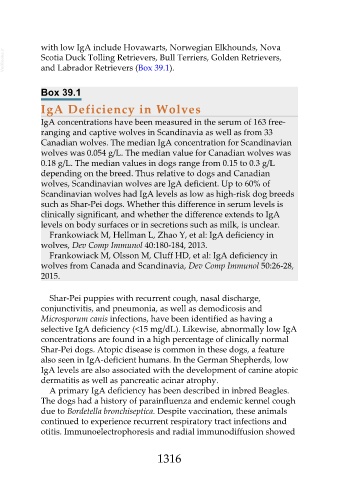Page 1316 - Veterinary Immunology, 10th Edition
P. 1316
with low IgA include Hovawarts, Norwegian Elkhounds, Nova
VetBooks.ir Scotia Duck Tolling Retrievers, Bull Terriers, Golden Retrievers,
and Labrador Retrievers (Box 39.1).
Box 39.1
IgA Deficiency in Wolves
IgA concentrations have been measured in the serum of 163 free-
ranging and captive wolves in Scandinavia as well as from 33
Canadian wolves. The median IgA concentration for Scandinavian
wolves was 0.054 g/L. The median value for Canadian wolves was
0.18 g/L. The median values in dogs range from 0.15 to 0.3 g/L
depending on the breed. Thus relative to dogs and Canadian
wolves, Scandinavian wolves are IgA deficient. Up to 60% of
Scandinavian wolves had IgA levels as low as high-risk dog breeds
such as Shar-Pei dogs. Whether this difference in serum levels is
clinically significant, and whether the difference extends to IgA
levels on body surfaces or in secretions such as milk, is unclear.
Frankowiack M, Hellman L, Zhao Y, et al: IgA deficiency in
wolves, Dev Comp Immunol 40:180-184, 2013.
Frankowiack M, Olsson M, Cluff HD, et al: IgA deficiency in
wolves from Canada and Scandinavia, Dev Comp Immunol 50:26-28,
2015.
Shar-Pei puppies with recurrent cough, nasal discharge,
conjunctivitis, and pneumonia, as well as demodicosis and
Microsporum canis infections, have been identified as having a
selective IgA deficiency (<15 mg/dL). Likewise, abnormally low IgA
concentrations are found in a high percentage of clinically normal
Shar-Pei dogs. Atopic disease is common in these dogs, a feature
also seen in IgA-deficient humans. In the German Shepherds, low
IgA levels are also associated with the development of canine atopic
dermatitis as well as pancreatic acinar atrophy.
A primary IgA deficiency has been described in inbred Beagles.
The dogs had a history of parainfluenza and endemic kennel cough
due to Bordetella bronchiseptica. Despite vaccination, these animals
continued to experience recurrent respiratory tract infections and
otitis. Immunoelectrophoresis and radial immunodiffusion showed
1316

